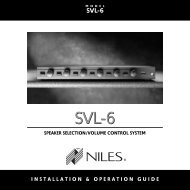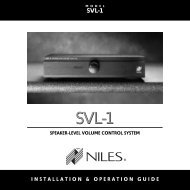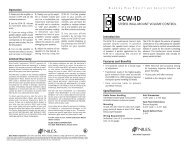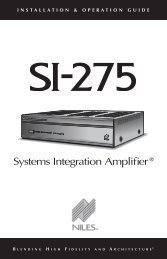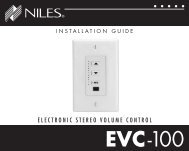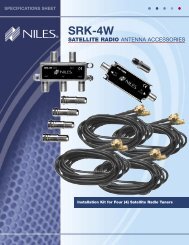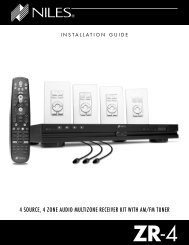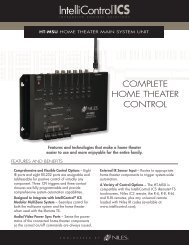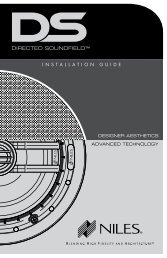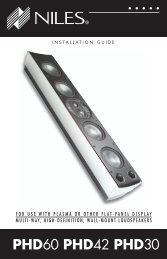HDLCR - Niles Audio
HDLCR - Niles Audio
HDLCR - Niles Audio
You also want an ePaper? Increase the reach of your titles
YUMPU automatically turns print PDFs into web optimized ePapers that Google loves.
• When drilling holes in ceiling joists, drill in the center of the joists and try to locate<br />
the hole near the end of the joist.<br />
IMPORTANT: DO NOT DRILL THROUGH A GLU-LAM OR LOAD-BEARING BEAM WITHOUT THE<br />
DIRECTION OF YOUR CONTRACTOR.<br />
• Try to line the holes up perfectly, because it makes pulling the wire much easier. A<br />
good technique is to snap a chalk line across the face of the studs or against the<br />
bottom of the ceiling joists. Then work backward so that you can always see the<br />
holes you have already drilled. Paying careful attention to this will save you time<br />
later on.<br />
PULLING THE CABLE<br />
Pull the cable in sections (from the stereo to the volume control, from the volume control to the<br />
speaker). Start with the longest sections and use leftover wire to complete the short sections. Also<br />
consider the following wiring tips:<br />
• If you plan to pull many rooms at the same time through a central route, walk off the<br />
Distance to each destination, add a generous “fudge factor” for turns and other<br />
Obstacles, and then cut off each section, so you can pull a bundle of wires at once.<br />
• When running the wire further than 4-1/2 feet from a hole in a stud or joist (e.g., open<br />
attic space, going up walls, etc.), be sure to fasten the wire to the joists or studs using<br />
cable clamps or appropriately-sized wire staples. The wire should not have large sags<br />
in it, nor should it be too tight.<br />
• Try to protect the wire from being stepped on in attics or other unfinished crawl<br />
spaces. Use guard strips, raceways, or conduits to protect the cable. Consult the local<br />
building code for special requirements in your area.<br />
CONCEALING SPEAKER WIRE<br />
ABOUT INTERIOR WALLS<br />
Interior walls in almost all North American residences are hollow, so they are easy installation sites<br />
for flush mounting speakers and routing new speaker cable in the house. Looking at a painted<br />
wallboard, plaster, or paneling, you only see the skin of the wall. Behind it is the home’s skeleton;<br />
2-by-4 inch wood or metal “studs” running vertically from the floor to the ceiling in walls and<br />
2-by-6 inch or larger “joists” running horizontally in the ceilings and floors. The space between the<br />
studs and joists is used for the home’s wiring and plumbing.<br />
NILES AUDIO CORPORATION – 1-800-BUY-HIFI<br />
(CONTINUED ON NEXT PAGE)<br />
11



